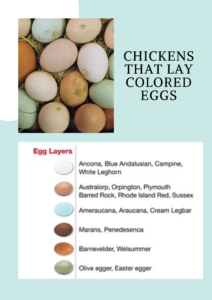Each chicken breed has specific genes that affect eggshell color. Chickens that lay colored eggs include Barred Rock, Rhode Island Red, Welsummer, Maran and Easter Egger hens. No matter the color, hens need balanced nutrition to lay eggs with strong, protective shells. Get strong eggs with the Oyster Strong® System, exclusively in Purina® premium and organic layer feeds.
 Collecting farm fresh eggs becomes even more fun when the shells are shades of the rainbow. From olive to pretty blue and speckled to chocolate brown, colored eggs are trending in the backyard chicken world. That’s why many chicken raisers keep a variety of breeds. No matter the shell color, your hens need calcium in their layer feed to lay strong and stay strong.
Collecting farm fresh eggs becomes even more fun when the shells are shades of the rainbow. From olive to pretty blue and speckled to chocolate brown, colored eggs are trending in the backyard chicken world. That’s why many chicken raisers keep a variety of breeds. No matter the shell color, your hens need calcium in their layer feed to lay strong and stay strong.
Chickens that lay colored eggs
Eggshell color is unique to each hen, depending on her breed and genetics. Eggshell color does not change egg nutrients; the color of the shell is simply decoration. Popular breeds that lay colored eggs include Barred Rock, Rhode Island Red, Ameraucana and Welsummer chickens.
Fun fact: You may be able to tell the shell color by the hen’s earlobe. Hens with white earlobes typically lay white or lightly tinted eggs. Hens with red earlobes most commonly lay brown eggs, but there are always exceptions to those rules. Different shades of eggshells can come from the same bird on different days. This is because the bloom, put on right before the egg is laid, contains a fair amount of pigment.
A hen will not change eggshell colors throughout her life; although, toward the beginning of a laying cycle the hue may be darker than towards the end of the cycle.
Some chicken keepers discover even more unique egg colors, like deep pink, dark green or speckled, by crossing different breeds. When a hen and rooster are mated, genes from both parents contribute to the eggshell color laid by their offspring.
Some of the most popular crosses are called Easter Egger or Olive Egger chickens. Easter Eggers can lay a variety of egg colors, from blue to green and sometimes even pink. Olive Eggers are aptly named for the olive-colored eggs they lay and are a result of crossing brown egg layers with blue egg layers.
How chicken egg colors are formed
All eggshells start white inside the hen, because shells are primarily calcium. If your hens lay colored eggs, look at the inside of the shells to see the importance of calcium:
- White eggs will be white all the way through
- Brown eggshells will be white on the inside
- Blue eggshells are blue all the way through
- Green eggshells will be blue on the inside and green on the outside
As your hen forms the shell, pigments called porphyrins are secreted from cells within the hen’s uterus to add color. Blue egg layers add pigment early in the shell formation process, which is why these shells are blue all the way through. A combination of blue and brown pigments produces a green shell color, as with an Olive Egger. Hens that lay white eggs do not produce any pigments during shell formation.
Hens need approximately 4 grams of calcium per day to form each eggshell. Hens that lack proper calcium levels typically produce soft or brittle eggshells. Sometimes an improper calcium balance can cause hens to pull calcium from their bones to produce eggshells, weakening their overall skeletal structure.
Choose a layer feed with the Purina® Oyster Strong® System to help your hens lay strong and stay strong. Which layer feed is right for your flock?
- Purina® Layena® pellets or crumbles Our most popular layer feeds
- Purina® Layena® Omega-3 Includes added omega-3 fatty acids for your health
- Purina® Organic Layer Feed Certified USDA Organic
Shop D&D Feed for all your poultry feeds and supplies.
